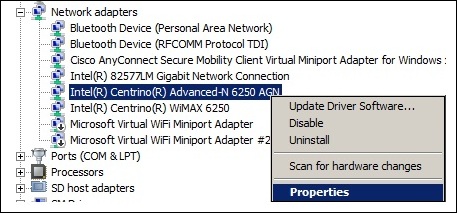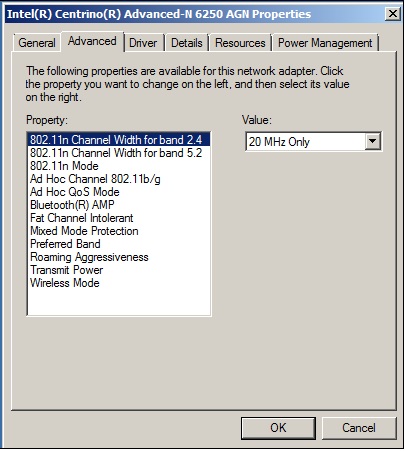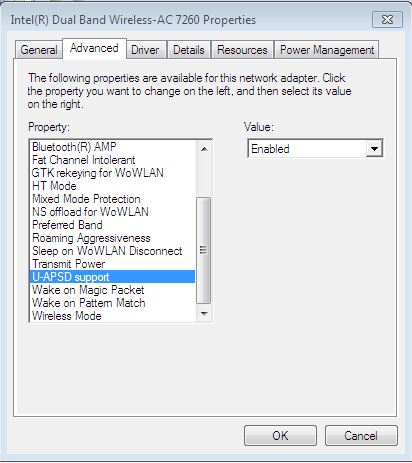Advanced Intel® Wireless Adapter Settings
Access and configure the advanced adapter settings to meet your wireless networking needs.
Click or the topic for details:
How to access the advanced adapter settings in Windows® 10
- Right-click Start in the bottom left corner.
- Click Device Manager.
- Click the > sign to expand the Network adapters entry.
- Right-click the wireless adapter and click Properties.
- Click the Advanced tab to configure the advanced settings.
How to access the advanced adapter settings in Windows 8*/8.1*
- Select Charms > Settings > PC Info (or you can also right-click Start icon in the bottom left corner.)
- Click Device Manager (located in the top left of screen).
- Click the > sign to expand the Network adapters entry.
- Right-click the wireless adapter and click Properties.
- Click the Advanced tab to configure the advanced settings.
How to access the advanced adapter settings in Windows 7*
- Right-click the My Computer icon on the desktop or from the Start menu.
- Click Manage.
- Click Device Manager.
- Click the + sign to expand the Network Adapters entry.
- Right-click the wireless adapter and click Properties.
- Click the Advanced tab to configure the advanced settings.


Advanced Wi-Fi adapter settings
Note Certain properties may not appear depending on the type of wireless adapter, driver version, or operating system installed. 802.11a/b/g Wireless Mode or Wireless Mode
Allows you to select whether the adapter operates in the 802.11b, 802.11g, and 802.11a bands.
- 802.11a only: Connect the wireless adapter to 802.11a networks only.
- 802.11b only: Connect the wireless adapter to 802.11b networks only.
- 802.11g only: Connect the wireless adapter to 802.11g networks only.
- 802.11a and 802.11g: Connect the wireless adapter to 802.11a and 802.11g networks only.
- 802.11b and 802.11g: Connect the wireless adapter to 802.11b and 802.11g networks only.
- 802.11a, 802.11b, and 802.11g (default): Connect to 802.11a, 802.11b, or 802.11g wireless networks.
Note To enable 802.11n/ac, keep the default setting for Wireless mode. Select HT mode for 802.11n, or VHT mode for 802.11ac under HT mode. 802.11n/ac/ax Wireless Mode or HT Mode
The setting lets you select 802.11n High Throughput mode (HT Mode), 802.11ac Very High Throughput Mode (VHT Mode), 802.11ax or disable 802.11n/ac/ax modes. Default value maybe 802.11ac or 802.11ax depending on the adapter you have.
- Disabled
- HT mode or 802.11n: enable 802.11n data rates
- VHT mode or 802.11ac: enables 802.11ac data rates
- 802.11ax: enables 802.11ax data rates
802.11n mode (for legacy 11n adapters only)
The 802.11n standard adds multiple-input multiple-output (MIMO). MIMO increases data throughput to improve the transfer rate. Use the setting to enable or disable high throughput mode support (MIMO – 802.11n).
- Enabled (default)
- Disabled
Notes
The settings are only available for the adapters:
- Intel® WiMAX/WiFi Link 5350
- Intel® WiMAX/WiFi Link 5150
- Intel® WiFi Link 5300
- Intel® WiFi Link 5100
- Intel® Wireless WiFi Link 4965AGN
For other newer adapters, HT Mode or 802.11n/ac Wireless Mode replaces this setting.
To achieve transfer rates greater than 54 Mbps on 802.11n connections, you must select WPA2-AES security. You can select no security (None) to enable network setup and troubleshooting. An administrator can enable or disable support for high throughput mode to reduce power consumption or conflicts with other bands or compatibility issues.
Channel width or 802.11n channel width(band 2.4/5GHz)
Use channel width to set high throughput mode channel width in order to maximize performance.
- Auto (default): For band 5GHz, this setting uses 20/40/80/160 MHz depending on the wireless access point or router
- 20 MHz
Ad-hoc channel 802.11 b/g
Ad-hoc channel 802.11 b/g is the band and channel selection for device to device (ad-hoc) networks. You don’t need to change the channel unless the other computers in the ad-hoc network are not using the default channel.
If you must change the channel, select the allowed operating channel:
- 802.11b/g (default): Select when using 802.11b and 802.11g (2.4 GHz) ad-hoc band frequency.
- 802.11a: Select when using 802.11a (5 GHz) ad-hoc band frequency.
Note This setting isn’t available on Windows® 10 Ad-hoc QoS mode
The Quality of Service (QoS) control in ad-hoc networks prioritizes traffic from the access point over a Wi-Fi Local Area Network (LAN) based on traffic classification. Wi-Fi Multimedia* (WMM*) is the QoS certification of the Wi-Fi Alliance* (WFA). When WMM is enabled, the adapter uses WMM to support priority tagging and queuing capabilities for Wi-Fi networks.
- WMM Enabled
- WMM Disabled (default)
Note This setting isn’t available on Windows® 10.
The feature isn’t installed through an Administrator Package when your computer has either an:
- Intel® PRO/Wireless 2915ABG Network Connection
- Intel® PRO/Wireless 2200BG Network Connection
ARP offloading for WoWLAN
ARP offload is the network adapter’s ability to respond to an IPv4 ARP request without waking the computer. To enable the feature, both the hardware and the driver must support ARP offload.
- Enabled (default)
- Disabled
Fat channel intolerant
The setting communicates to surrounding networks that the Wi-Fi adapter isn’t tolerant of 40 MHz channels in the 2.4 GHz band. When disabled the adapter doesn’t send this notification.
- Enabled
- Disabled (default)
Global BG scan blocking
By default, the Wi-Fi adapter will perform periodic scan for other available Access Points (AP).
Disabling this behavior can be helpful when using application software that is sensitive to brief interruptions in network connectivity.
- Always: Will not perform periodic scans for other available APs.
- Never (default): Will perform periodic scans for other available APs.
- On Good RSSI: Will only perform periodic scans for other available APs when the current AP’s signal strength is low.
Note It is not recommended to change this setting for users who are mobile throughout the day. GTK rekeying for WoWLAN
Group Temporal Key (GTK) Rekey is used to encrypt and decrypt network traffic.
- Enabled (default)
- Disabled
MIMO power save modeMIMO power save mode, also known as spatial multiplexing power save (SMPS) mode, allows the client to save power by keeping one antenna in a receive idle state.
- Auto SMPS (default): The client decides automatically what SMPS mode to apply depends on different conditions.
- Dynamic SMPS: The client keeps only one antenna active. The access point (AP) must send request to send (RTS) packet to trigger the client to wake the sleeping radios/antenna before sending MIMO packets.
- Static SMPS: The client keeps only one antenna active and the AP cannot send MIMO packets to the client.
- No SMPS: The client always keeps all antennas active and the AP can send MIMO packets to the client.
Note Some legacy APs may have compatibility issue with supporting the SMPS mode and may cause various link quality problems such as low throughput. Change this setting to No SMPS may help to work around the issue. Mixed mode protection
Use mixed mode protection to avoid data collisions in a mixed 802.11b and 802.11g environment. Use Request to Send/Clear to Send (RTS/CTS) in an environment where clients may not hear each other. Use CTS-to-self to gain more throughput in an environment where clients are within hearing proximity.
- CTS-to-self Enabled
- RTS/CTS Enabled (default)
Note The setting isn’t valid when 802.11n mode is enabled. NS offloading for WoWLAN
NS offload is the network adapter’s ability to respond to a Neighbor Discovery Neighbor Solicitation request with a Neighbor Advertisement without waking the computer. Both the hardware and the driver must support NS offload to enable this feature.
- Enabled (default)
- Disabled
Packet Coalescing
Enables power saving by reducing the number of receive interrupts. The feature reduces receive interrupts by coalescing random broadcast or multicast packets.
- Enabled (default)
- Disabled
Preferred bandIn an environment with other radiating devices nearby (such as microwave ovens, cordless telephones, access points, or client devices), in order to reduce interference, you may prefer the 5GHz band over the 2.4GHz band, or the reverse.
- No Preference (default)
- Prefer 2.4 GHz band
- Prefer 5 GHz band
Roaming aggressiveness
This setting alters the signal strength threshold at which the WiFi adapter starts scanning for another candidate AP. The default value is Medium. Depending on the environment, one option may work better than the other. You may try other values to see which works best for your environment. However, it is recommended to revert back to the default (Medium) if no improvement is observed with other values.
- Lowest: The WiFi adapter will trigger scan a for another candidate AP when the signal strength with the current AP is very low.
- Medium-Low
- Medium (default): Recommended value.
- Medium-High
- Highest: The WiFi adapter will trigger scan a for another candidate AP when the signal strength with the current AP is still good.
Sleep on WoWLAN disconnect
Sleep on WoWLAN Disconnect is the ability to put the device to sleep/drop connection when WoWLAN is disconnected.
- Enabled
- Disabled (default)
Throughput Booster or Throughput Enhancement
Enhance the transmit throughput by enabling packet bursting.
When this setting is enabled and the client (Wi-Fi adapter) has buffered enough data, the client is able to hold longer possession of the air medium than it normally does to send the data to the Access Point (AP).
This only improves the upload throughput (from client to the AP) and is mostly effective for usages like uploading large files or upstream benchmarks.
- Enabled
- Disabled (default)
Note In a Wi-Fi network only one client can transmit at a time. So the throughput for other clients in the same network may be negatively impacted when this feature is enabled.
Note:
Transmit power
The optimal setting is to set the transmit power at the lowest possible level still compatible with communication quality. The setting allows the maximum number of wireless devices to operate in dense areas. It reduces interference with other devices that share the radio spectrum. If you decrease the transmit power, you reduce the radio coverage.
- Lowest: Sets the adapter to the lowest transmit power. Increase the number of coverage areas or confine a coverage area. You should reduce the coverage area in high traffic areas to improve overall transmission quality and avoid congestion or interference with other devices.
- Medium-low, Medium, or Medium-high: Set by country requirements.
- Highest (Default): Sets the transmit level of the adapter to a maximum. Use this setting in environments with limited radio devices for maximum performance and range.
Note
This setting takes effect when either Network (Infrastructure) or Device to Device (ad-hoc) mode is used.
U-APSD support
U-APSD (or WMM-Power Save or WMM-PS) is a Wi-Fi capability that saves power consumption on low periodic latency-sensitive traffic modes, like a VoIP. We have identified interoperability (IOT) issues with certain access points that result in reduced RX throughput.
- Enabled
- Disabled (default)

Wake on magic packet
If enabled, the setting wakes the computer from a sleep state when it receives a Magic Packet from a sending computer. The Magic Packet contains the MAC address of the intended destination computer. Enabling turns on Wake on Magic Packet. Disabling turns off Wake on Magic Packet. It only disables the Magic Packet feature, not Wake on Wireless LAN.
- Enabled (default)
- Disabled
Wake on pattern match
Wakes the computer from a sleep state when an adapter receives a particular wake pattern. Window 7*, Windows 8* and Windows® 10 support the feature. Patterns are typically:
- Wake on new incoming TCP connection for IPv4 and IPv6 (TCP SYN IPv4 and TCP SYN IPv6)
- Wake on 802.1x reauthentication packets
Disabling only disables the pattern match feature, not Wake on Wireless LAN.
- Enabled (default)
- Disabled















![Toni Kroos là ai? [ sự thật về tiểu sử đầy đủ Toni Kroos ]](https://evbn.org/wp-content/uploads/New-Project-6635-1671934592.jpg)


